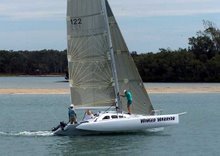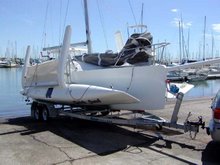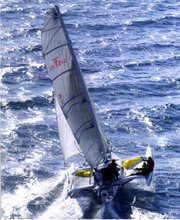skip to main |
skip to sidebar

So why is this boat called Lydius? Well, it is the name of my grandfather. He died when I was 6 years old, but I got some great moments with him. Here is one of them.

 I Started building in Dec. and sat up form frames for the first half. These pictures are from the 3 half but the principles are the same only the frames are reversed here to make the two last half's.Then comes stringers and foam, hot formed and fasten from the out side.
I Started building in Dec. and sat up form frames for the first half. These pictures are from the 3 half but the principles are the same only the frames are reversed here to make the two last half's.Then comes stringers and foam, hot formed and fasten from the out side.
Working as a sail maker i was offered a Dragonfly 25 that needed some work after it got hit by another boat during a storm in the Mediterranean, but it proved to be to expensive for this old boat, and it took 3 persons half a day to put it together. Then I started looking for a design I could build for myself, and eventually I came across this fine design. If you want to know more about this boat please look at Ian Farriers site.
The main idea would be:
- it is fast
- it is foldable ( 1 person can do it in minutes)
- it is epoxy/foam/glass/carbon built ( not just csmglass and polyester)
- you can trail the boat to whereever you like to sail.
But this boat is more expensive than Dragonfly 25 so even if I build it myself. I really had to convince myself that this was what I really wanted. A coincidense made the trick. A new zealander had his plans up for graps so I jumped right into it and said to myself that now I do this and take any problems that would arrice from the top and bring them down.
First I had to build a shed, I did this in 2005/2006 while also doing house fixing and finished another small boat I had going in my old workshop. The new workshop is insulated since Denmark can be quite a cold place during the winter. I was glad that many of my friends helped with left overs or recycled materials to make this shed as cheap as possible. It is going down when the boat is finished.
Welcome to my new blog.This blog is to show the progress in building a F82R trimaran designed by Ian Farrier, and maybe to write anything else that got my interest.
The name for the blog is the names of my two granddads. These names are by far not normal in Denmark and they sound so funny to me. Maybe the name of the boat??
The first photo is me at age 6 in the kindergarden where we used to do a lot of outdoor activities. I think we are building some kind of big box for a house to use for playing.
 Winter outside shed, showing double door that can open in summer.
Winter outside shed, showing double door that can open in summer. But inside my warm shed I start the carbon chain plates soon to be fitted in floats. Here foam is being straitened with a big power plane. Working with foam is like very soft wood.
But inside my warm shed I start the carbon chain plates soon to be fitted in floats. Here foam is being straitened with a big power plane. Working with foam is like very soft wood. Next a groove is filed in top to accept thimble.
Next a groove is filed in top to accept thimble. And glued with high density bog.
And glued with high density bog. Wipe of glue and let set. The top 50 mm is high density foam. I see from the F22 builders that they use a G10 tubing for thimble, maybe that is the new style (lighter) or maybe not strong enough for F82.
Wipe of glue and let set. The top 50 mm is high density foam. I see from the F22 builders that they use a G10 tubing for thimble, maybe that is the new style (lighter) or maybe not strong enough for F82. The winter came suddenly with surprise to all in Denmark, all though this happen every year with traffic panic etc. Had to go to Copenhagen in the blizzard. But we managed well.
The winter came suddenly with surprise to all in Denmark, all though this happen every year with traffic panic etc. Had to go to Copenhagen in the blizzard. But we managed well. I was going to christen the future crew, in this case my nephew Sofus Felix Klein Friderichsen, son of my brother Anders (to my right) and his wife Rikke( to Anders right). Far left is Jacob the second brother of mine.
I was going to christen the future crew, in this case my nephew Sofus Felix Klein Friderichsen, son of my brother Anders (to my right) and his wife Rikke( to Anders right). Far left is Jacob the second brother of mine.
















































